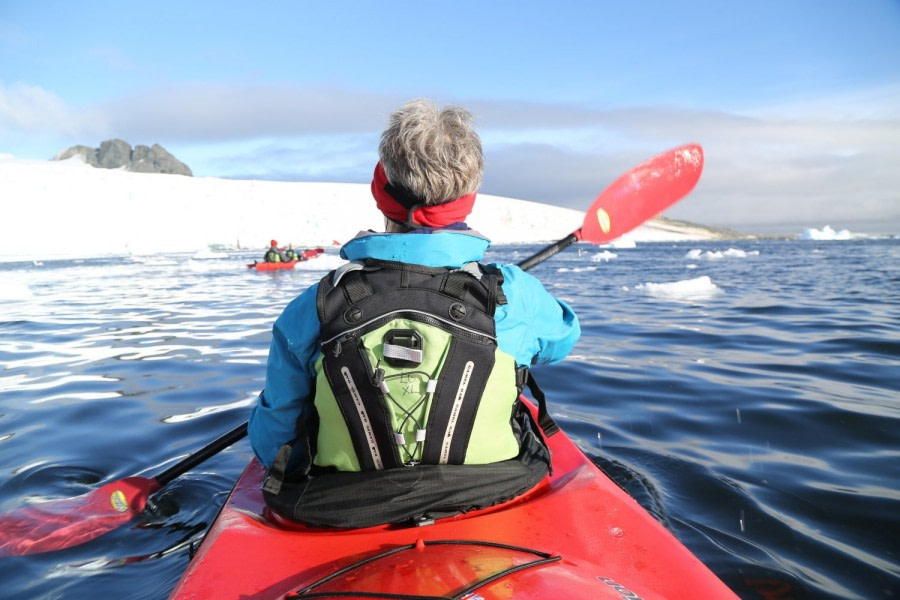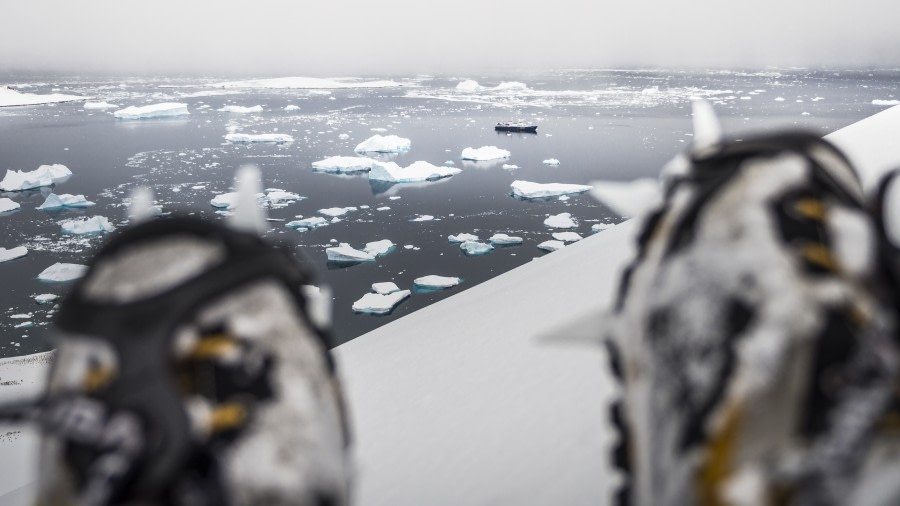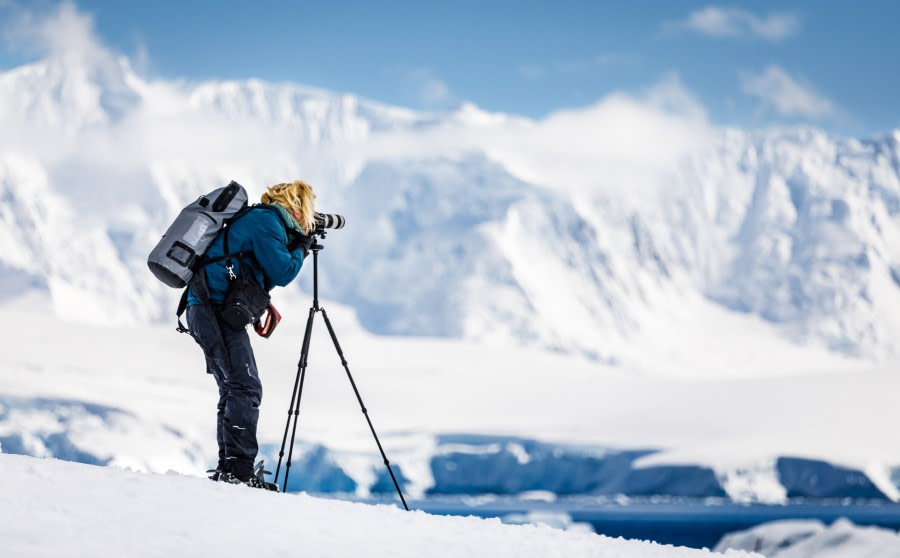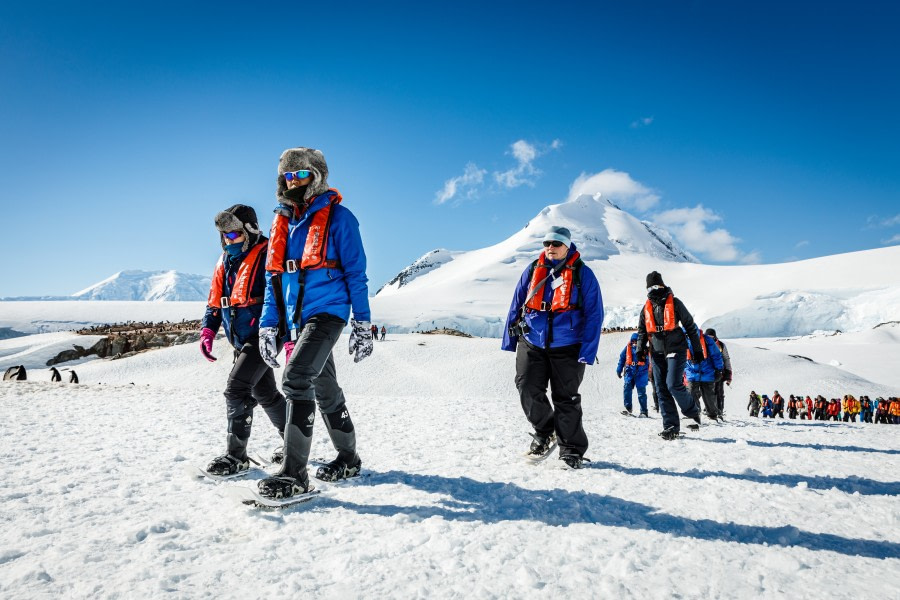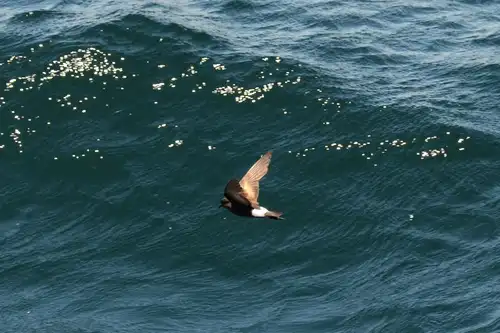







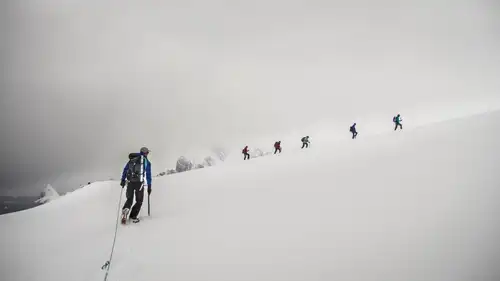

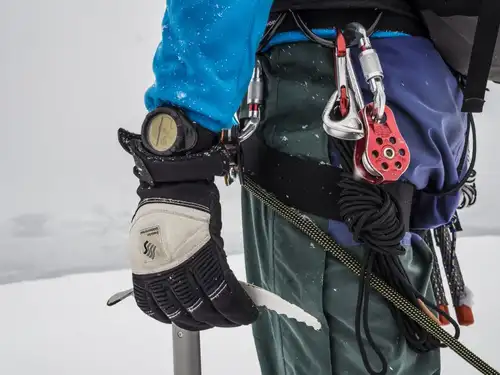










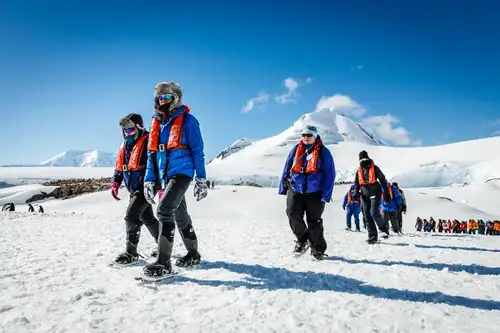

























 13 Days/12 Nights
13 Days/12 Nights




Note: All itineraries are for guidance only. Programs may vary depending on ice, weather, and wildlife conditions. Landings are subject to site availabilities, permissions, and environmental concerns per AECO regulations.
Your expedition begins where the world drops off. Ushuaia, Argentina, reputed to be the southernmost city on the planet, is located on the far southern tip of South America. Starting in the afternoon, you set off from this small resort town on Tierra del Fuego, nicknamed “The End of the World,” and sail the mountain-fringed Beagle Channel for the remainder of the evening.
Path of the polar explorers
Over the next two days on the Drake Passage, you enjoy some of the same experiences encountered by the great polar explorers who first charted these regions: cool salt breezes, rolling seas, maybe even a fin whale spouting up sea spray. After passing the Antarctic Convergence – Antarctica’s natural boundary, formed when north-flowing cold waters collide with warmer sub-Antarctic seas – you are in the circum-Antarctic upwelling zone. Not only does the marine life change, the avian life changes too. Wandering albatrosses, grey-headed albatrosses, black-browed albatrosses, light-mantled sooty albatrosses, cape pigeons, southern fulmars, Wilson’s storm petrels, blue petrels, and Antarctic petrels are a few of the birds you might see.
Entering Antarctica
Gray stone peaks sketched with snow, towers of broken blue-white ice, and dramatically different wildlife below and above. You first pass the snow-capped Melchior Islands and Schollaert Channel, sailing between Brabant and Anvers Islands.
Places you might visit include:
- Neumayer Channel – The vessel may position itself here, launching its multiple basecamp activities from the protected waters around Wiencke Island. You can enjoy the splendors of this alpine environment at sea with Zodiac and kayaking trips, or if you’re in the mood for a walk, there are possible snowshoe hikes and soft-climb mountaineering options farther inland. Naturally, favorable weather conditions determine the possible activities.
- Port Lockroy – After sailing through the Neumayer Channel, you may get a chance to visit the former British research station – now a museum and post office – of Port Lockroy on Goudier Island. You may also be able to partake in activities around Jougla Point, meeting gentoo penguins and blue-eyed shags. At the nearby sites, such as Damoy Point there may be the opportunity for snowshoeing to the old ski-way, this is also one of our favourite camping sites.
- Pléneau & Petermann Islands – If the ice allows it, you can sail through the Lemaire Channel in search of Adélie penguins and blue-eyed shags. There’s also a good chance you’ll encounter humpback and minke whales here, as well as leopard seals. Kayaking, glacier walks, and more ambitious mountaineering trips are the potential activities of this location.
- Neko Harbour – An epic landscape of mammoth glaciers and endless wind-carved snow, Neko Harbour offers opportunities for a Zodiac cruise and landing that afford the closest views of the surrounding alpine peaks.
- Paradise Bay – You have the chance to make camp here like a true polar explorer, enjoying a supreme overnight Antarctic adventure.
- Errera Channel – Possible sites in this area include Danco Island and Cuverville Island, but also the lesser known (though equally picturesque) Orne Island and Georges Point on Rongé Island.
On your last day of near-shore activities, you pass the Melchior Islands toward the open sea. Keep a sharp lookout for humpback whales in Dallmann Bay. You might also shoot for Half Moon Island, in the South Shetlands, with further chances for activities.
Conditions on the Drake Passage determine the exact time of departure.
Familiar seas, familiar friends
Your return cruise is far from lonely. While crossing the Drake, you’re again greeted by the vast array of seabirds remembered from the passage south. But they seem a little more familiar to you now, and you to them.
There and back again
Every adventure, no matter how grand, must eventually come to an end. It’s now time to disembark in Ushuaia, but with memories that will accompany you wherever your next adventure lies.

Camping in the Antarctic Wilderness
For a truly immersive polar adventure, our open-air camping activity lets you experience the Antarctic wilderness like few travelers have. We provide the necessary camping gear, including breathable bivouac bags that are wind and waterproof, and polar sleeping bags to keep you warm and comfortable during the enchanting Antarctic night. Experienced expedition guides will assist and supervise all campers.
Hiking the Surreal Terrain of the Arctic and Antarctica
There's no better way to explore a new area than on foot. We offer a variety of hiking expeditions for all levels, from casual walkers to hard-core enthusiasts.
Explore the Arctic and Antarctic Coastline in a Kayak
Even after exploring shores, mountains, and spotting wildlife, there’s a whole world to discover on the water. Polar kayaking offers a unique way to experience the blue-and-white beauty of the polar seas, visiting stunning ice formations and waterways too small for our ships.
Dramatic Ascents and Breathtaking Descents
Looking for an adventure beyond shoreline walks and wildlife watching? Our ski mountaineering trips offer an invigorating, up-close experience of the rugged peaks and majestic mountains flanking the high Arctic fjords.
Join Our Expert-Led Photography Workshops
Visiting the polar regions is an indescribable experience. Our photography workshops help you capture incredible photos to complement your descriptions. On select voyages, professional photographers assist you in getting the best shots with your camera equipment through our free photo workshop activity.
Snowshoeing in the Arctic and Antarctica
Exploring a new place on foot is one of the best ways to truly experience it. With this in mind, Oceanwide Expeditions offers a variety of snowshoeing expeditions from the Polar shorelines, designed for everyone—from casual explorers to avid snowshoe enthusiasts.








































































m/v Plancius
Our most longstanding vessel, Plancius, is a classic choice for many of our most popular polar voyages.

Specifications
| Passengers: | 108 passengers in 50 cabins |
| Staff & crew: | Crew 40 | Guides 8 | Doctor 1 |
| Length: | 89 meters (293 feet) |
| Breadth: | 14,5 meters (47 feet) |
| Draft: | 5 meters (16 feet) |
| Ice class: | 1D (Plancius has a Lloyds class notation 100A1 Passenger ship, Ice Class 1D at a draught of 5 meters) |
| Displacement: | 3211 tonnes |
| Propulsion: | 3x Diesel-Electric |
| Speed: | 10.5 knots average cruising speed |
Cabins Gallery


Ship Interior Gallery


Ship Exterior Gallery


M/v “Plancius” was built in 1976 as an oceanographic research vessel for the Royal Dutch Navy and was named “Hr. Ms. Tydeman”. The ship sailed for the Dutch Navy until June 2004 and was eventually purchased by the company. The vessel was completely rebuilt as a passenger vessel in 2009 and complies with the latest SOLAS-regulations (Safety Of Life At Sea). M/v “Plancius” is classed by Lloyd’s Register and flies the Dutch flag.
Perfect for any expedition
M/v “Plancius” accommodates 108 passengers with private toilets and shower in 4 quadruple porthole cabins, 9 twin porthole cabins, 25 twin cabins with windows and 2 twin deluxe cabins, all (ca. 12,5 square meters) and 10 twin superior cabins (ca. 21 square meters). All cabins offer lower berths (one queen-size bed in the superior cabins and two single beds in the twin cabins), except for the 4 quadruple cabins (for 4 persons in 2x upper and lower beds).
Plancius: a vessel with comfort and character
Please be aware that a small number of cabins may have a partially obstructed view due to the design requirements of the ship. The best view is always on the outer deck or the bridge. The vessel offers a restaurant/lecture room on deck 3 and a spacious observation lounge (with bar) on deck 5 with large windows, offering a full panorama view. M/v “Plancius” has large open deck spaces (with full walk-around possibilities on deck 4), giving excellent opportunities to enjoy the scenery and wildlife. She is furthermore equipped with 10 Mark V zodiacs, including 40 HP 4-stroke outboard engines and 2 gangways on the starboard side, guaranteeing a swift zodiac operation.
M/v “Plancius” is comfortable and nicely decorated, but is not a luxury vessel. Our voyages in the Arctic and Antarctic regions are primarily defined by an exploratory educational travel program, spending as much time ashore as possible. Plancius fully meets our demands to achieve this. The vessel is equipped with a diesel-electric propulsion system which reduces the noise and vibration of the vessel considerably. The 3 diesel engines generate 1.230 horsepower each, giving the vessel a speed of 10 - 12 knots. The vessel is ice-strengthened and was specially built for oceanographic voyages. M/v “Plancius” is manned by an international crew of 40 (20 nautical crew and 20 hotel crew), 8 expedition staff (1 expedition leader, 1 assistant expedition leader and 6 guides/lecturers), and 1 doctor.
Age and Nationality
Passengers on a typical voyage range from their 30s to their 80s - with a majority usually from 45 - 65. Our expeditions attract independent-minded travelers from around the world. They are characterized by a strong interest in exploring remote regions. The camaraderie and spirit that develops aboard is an important part of the expedition experience. Many departures have several nationalities on board.
Dress code
In keeping with our expedition atmosphere, dress on board is informal. Bring casual and comfortable clothing for all activities. Keep in mind that much of the spectacular scenery can be appreciated from deck, which can be slippery. Bring sturdy shoes with no-slip soles and make sure the parka is never far away in case of the call "Whales!" comes over the loudspeaker and you have to dash outside. Wear layers since it is comfortably warm aboard the ship - and often cold on deck.
Currency & payment
Refreshments from the bar and souvenirs will be charged to your cabin. The day before departure you can settle your bill with the Hotel Manager and pay by credit card (Visa or MasterCard) or cash (Euro or Dollar). We do not accept cheques of any kind. The price and standard currency on board our vessels is the Euro. Other currencies may be accepted at the discretion of the hotel manager at prevailing rates.
Electric current
The electrical supply aboard the ship is 220v, 60Hz. Electrical outlets are standard European with two thick round pins. You may need a 220v/110v converter.
Gratuities
The customary gratuity to the ship's service personnel is made as a blanket contribution at the end of the voyage which is divided among the crew. Tipping is a very personal matter and the amount you wish to give is at your discretion. As a generally accepted guideline, we suggest US$8 to US$10 per person per day. It is better for the crew, if you can give them cash US Dollar.
Non-smoking policy
On board our vessels we have a non-smoking policy. It is prohibited to smoke inside the ship. You can smoke in the designated smoking areas. Please respect the wishes of non-smokers.
Your physical condition
You must be in good general health and you should be able to walk several hours per day. The expedition is ship-based and physically not very demanding. Although we spend as much time as possible ashore, you are welcome to remain aboard the ship if you like. To join most excursions, you must be able to get up and down the steep gangway from the ship to the water level to board the Zodiacs. Staff will assist you in and out of the boats. This will become progressively easier with practice. Ashore it can be slippery and rocky. You are travelling in remote areas without access to sophisticated medical facilities, so you must not join this expedition if you have a life-threatening condition, or need daily medical treatment.

The average price for flights (round trip) to Ushuaia
From Jakarta: $2,848
From Singapore: $3,500
From Kuala Lumpur: $3,600
Insurance Requirements:
- Mandatory Insurance: All travelers must have insurance covering medical expenses, accidents, and repatriation/evacuation.
- Recommended Insurance: It is strongly recommended to include cancellation insurance for added protection.
Drone Usage Policy:
- Prohibited: The use of drones is strictly prohibited during the expedition.
Clothing and Gear Recommendations:
- Water-Resistant Coat and Pants: Essential for protection against the wet and windy conditions.
- Layered Underwear: To ensure warmth and comfort in extreme weather.
- Sunglasses: Necessary to protect against the strong UV rays and glare from the snow.
- Gloves: Insulated and water-resistant gloves to keep your hands warm and dry.
- Additional Items: Consider packing a warm hat, thermal socks, and sturdy waterproof boots.
- Voyage aboard the indicated vessel as indicated in the itinerary
- All meals throughout the voyage aboard the ship including snacks, coffee and tea.
- All shore excursions and activities throughout the voyage by Zodiac.
- Program of lectures by noted naturalists and leadership by experienced expedition staff.
- Free use of rubber boots and snowshoes.
- Pre-scheduled group transfer from the vessel to the airport in Ushuaia (directly after disembarkation).
- All miscellaneous service taxes and port charges throughout the programme.
- Comprehensive pre-departure material.
- Any airfare, whether on scheduled or charter flights
- Pre- and post- land arrangements.
- Passport and visa expenses.
- Government arrival and departure taxes.
- Meals ashore.
- Personal health Insurance for Medical, Accident and Repatriation/evacuating..
- Excess baggage charges and all items of a personal nature such as laundry, beverage charges and Internet charges.
- The customary gratuity at the end of the voyages for stewards and other service personnel aboard (guidelines will be provided).
- You need to be in good general health and able to walk several hours per day. Though our expeditions are ship-based, they can be physically demanding. You can choose to stay on the vessel if you prefer, but you will still need to be able to move safely around the ship even in bad weather. Assuming you choose to join landings, you will need to be able to get in and out of the Zodiacs. You must also be capable of getting up and down the gangway. This will become easier with practice, but the gangway is steep and moves with the rocking of the vessel. Conditions on shore can also be rocky, uneven, and slippery, and we will be in remote areas without access to sophisticated medical facilities. You must not join an expedition if you have a life-threatening condition or need daily medical treatment. Any major health problem or physical condition that requires emergency care must be brought to our attention prior to the voyage. Please fill out our Personal Information Form, which we will send at the time of booking. This form must be completed and returned within one month of your book date. Since we travel in such remote areas, medical evacuation by air is often impossible. We therefore reserve the right to refuse travel or participation in activities to anyone whose health concerns might pose a safety risk to our staff or other passengers.
- Yes, but the minimum age we can allow on board is three years old, however we advise against travelling with children under 8 years old. The maximum age we consider to be a child is 16 years old. We offer a 40% child discount in certain cabin types on a selection of voyages for children between three and 15 years old.
- The currency used on all vessels is the Euro, but you can also pay with USD.
- No, you are not able to change currency on board.
- The Antarctic Peninsula follows Coordinated Universal Time -3 (UTC -3). This means that if it is 18:00 UTC-3 (6 p.m.) during your expedition cruise trip to the Antarctic Peninsula , it would be 17:00 (5 p.m.) in New York City, USA and 22:00 (10 p.m.) in London, U.K.
- The Antarctic Peninsula is one of the most beautiful regions of the entire continent. Your cruise to the Antarctic Peninsula will reveal the most diverse mixture of wildlife throughout Antarctica. The scenery in this region is dramatic, filled with icebergs and of course, very photo-worthy. The prevalence of penguins is a highlight during most expeditions, and a visit during the summer can even reveal plant life such as the area's only two flowering plants: the Antarctic pearlwart and Antarctic hair grass.
- There is place for 116 passengers aboard the Plancius. Furthermore there are 45 staff & crew on board : 17 nautical crew, 19 hotel staff (6 chefs, 1 hotel manager, 1 steward-barman and 11 stewards/cabin cleaners), 7 or 8 expedition staff and 1 doctor on board.
- There are in total 50 cabins at the Plancius: 4 quadruple cabins with private toilet and shower 9 twin porthole cabins 25 twin cabins with window 2 twin deluxe cabins (ca 15 square meters) 10 superior cabins (ca 21 square meters)
You May Also Like



Antarctica - Basecamp - free camping, kayaking, snowshoe/hiking, mountaineering, photo workshop
 13 Days / 12 Nights
13 Days / 12 Nights

Falkland Islands - South Georgia - Antarctica
 20 Days / 19 Nights
20 Days / 19 Nights

Falkland Islands – South Georgia – Antarctica
 20 Days / 19 Nights
20 Days / 19 Nights

Antarctica - Discovery and learning voyage
 11 Days / 10 Nights
11 Days / 10 Nights

Antarctica - Discovery and learning voyage + navigational workshop
 11 Days / 10 Nights
11 Days / 10 Nights
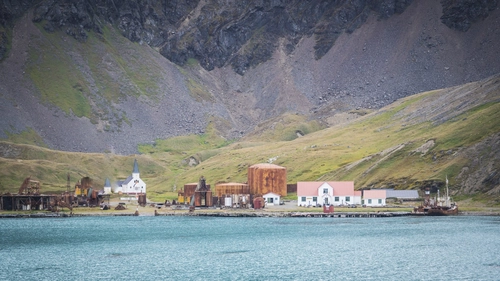
Falkland Islands - South Georgia - Elephant Island - Antarctica - Polar Circle
 23 Days / 22 Nights
23 Days / 22 Nights

Antarctica - Elephant Island - Weddell Sea - Polar Circle
 15 Days / 14 Nights
15 Days / 14 Nights

Antarctica - Polar Circle - Deep South Discovery voyage
 12 Days / 11 Nights
12 Days / 11 Nights

Antarctica - Whale watching discovery and learning voyage
 10 Days / 9 Nights
10 Days / 9 Nights

Antarctica - Beyond the Polar Circle - Wilkins Ice Shelf - Aurora Australis
 16 Days / 15 Nights
16 Days / 15 Nights

Antarctica - Polar Circle - Whale watching
 12 Days / 11 Nights
12 Days / 11 Nights

Falklands, South Georgia and Antarctica - Photographic Special
 21 Days / 20 Nights
21 Days / 20 Nights

Weddell Sea – In search of the Emperor Penguin, incl. helicopters
 11 Days / 10 Nights
11 Days / 10 Nights

Antarctica - Beyond the Polar Circle - whale watching
 12 Days / 11 Nights
12 Days / 11 Nights

Antarctica - Whale watching
 10 Days / 9 Nights
10 Days / 9 Nights

Camping in Antarctica: a True Expedition Experience

Eight Antarctic Misconceptions
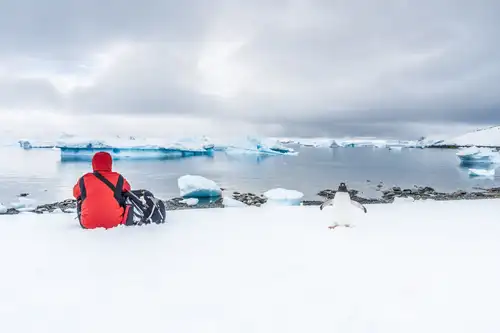
Adding Antarctica to Your Seven-Continents Bucket List

The Classic Polar Cruise: Antarctic Peninsula Facts, Pics, and More

Six Facts About the Crabeater Seals of Antarctica

Arctic and Antarctic Basecamp Cruises – Choose Your Own Adventure

15 Fantastic Photos of Antarctica

The Emperor Penguin of the Drake Passage

Life in a Penguin Colony

8 Whales You Might See During Your Antarctica Cruise

Albatross, penguin and krill research in Antarctica

The Eight Great Penguin Species of Antarctica
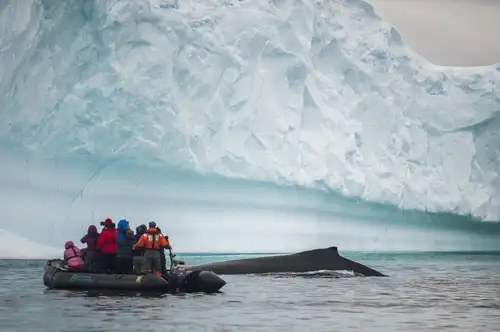
A Day of Whale Watching in Antarctica

Wreck Diving in Antarctica

Port Lockroy: History, Post Office, and Resident Penguins

Graham Land: A landscape dominated by volcanoes

The Research Stations of Antarctica and the sub-Antarctic

The Eight Albatrosses of Antarctica and the Sub-Antarctic

Danger Beneath the Water: 10 Facts About Leopard Seals













